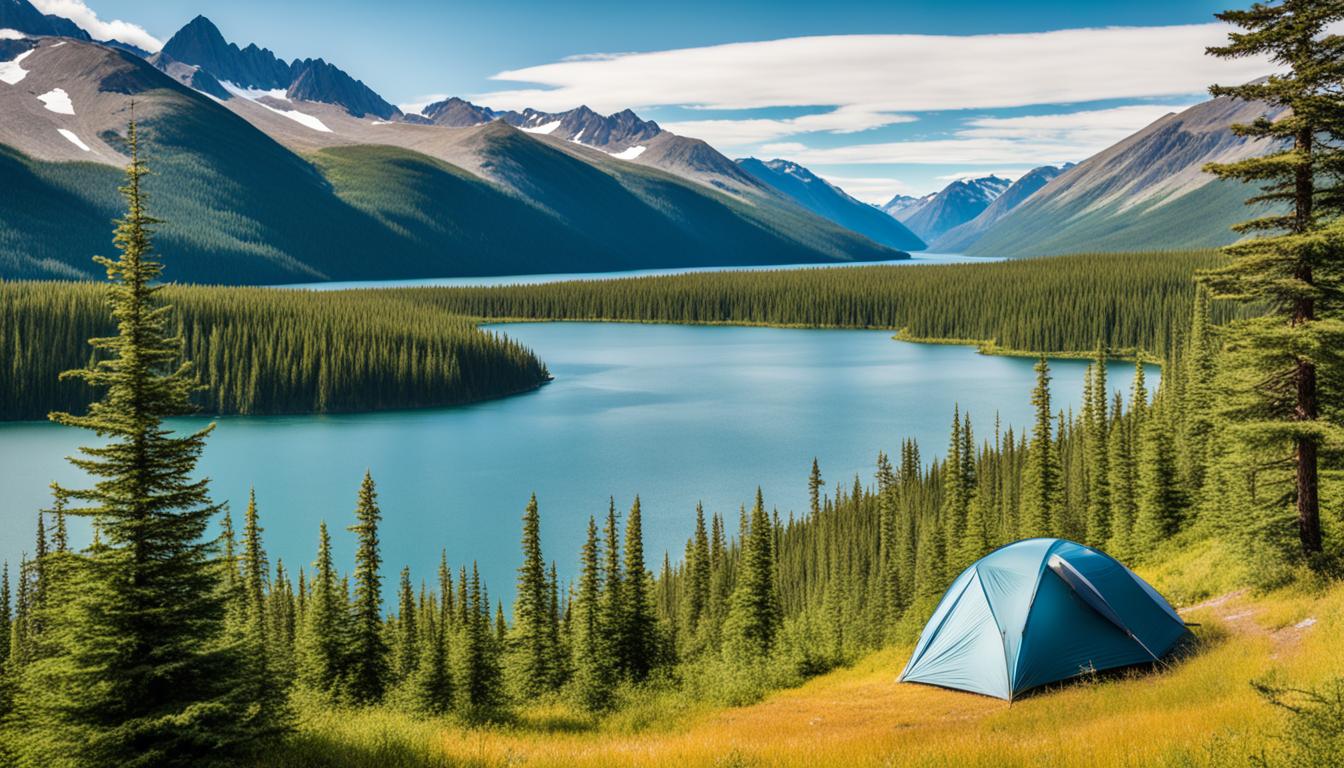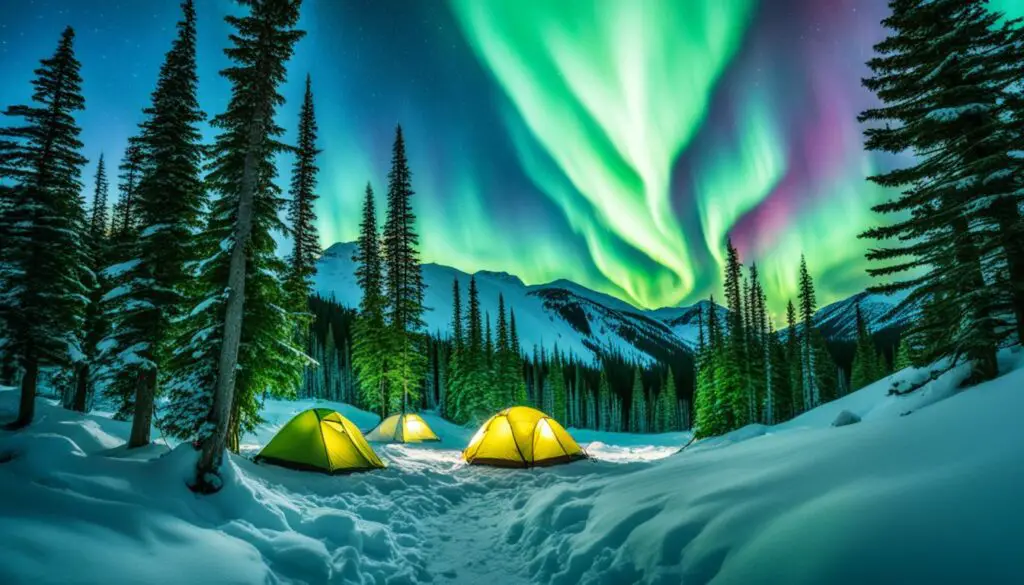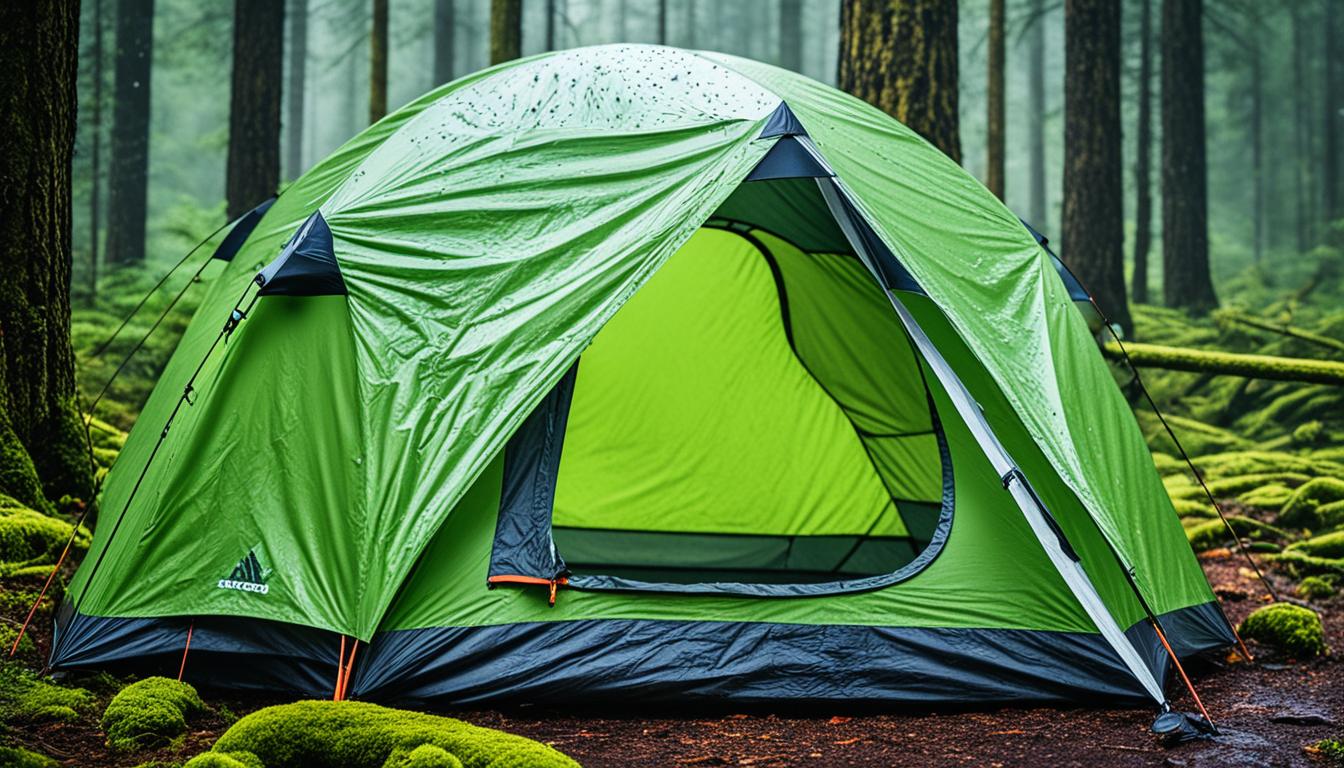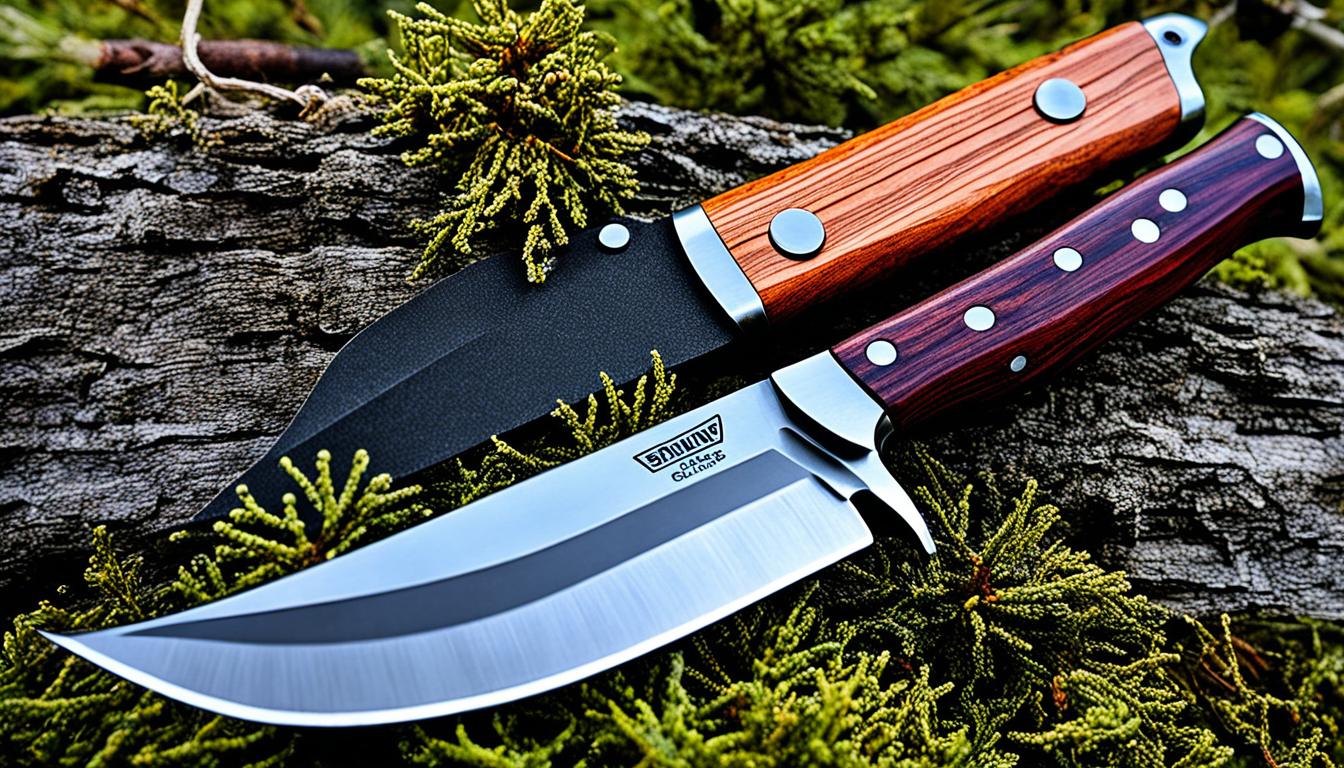
Camping in Alaska can be a thrilling adventure in the vast wilderness. However, it’s crucial to know the risks and be prepared for a safe trip. I, as an experienced camper, am thrilled by Alaska’s natural beauty. I look forward to sharing tips on how to camp safely in this amazing state.
Alaska’s wilderness is a stunning place for outdoor adventures. Yet, it comes with wildlife encounters and unpredictable weather. When planning a camping trip, these risks should always be kept in mind.
In this guide, I’ll go over the important things to consider for camping in Alaska. My aim is to help you have a great time while keeping safe. Whether you’re new to camping or an expert, I want to give you the knowledge for an unforgettable trip in Alaska.
The Allure of Camping in Alaska’s Wilderness
Alaska’s wilderness is known for its breathtaking natural beauty. It has towering mountains, glacial lakes, and dense forests. Camping here lets you experience the serene solitude of nature, far from daily life’s noise. But, it’s important to be ready for the challenges of camping in this remote region.
Unparalleled Natural Beauty
In Alaska, nature’s wonders are everywhere. You can walk through green forests or see the Alaska Range’s high peaks. Camping here shows you the power and peace of Alaska’s outdoor experiences.
Serene Solitude
Camping in Alaska’s wilderness is perfect for getting away from it all. When you camp under the Alaska sky, you feel deep peace. The quiet is only broken by animal sounds and the wind. It’s a calming way to connect with nature.
Camping in Alaska’s natural landscapes is a life-changing adventure. The wilderness calls out to adventurers and nature fans. It offers stunning views and a quiet escape from everyday life. Camping in Alaska’s wilderness is a journey you won’t forget into one of the last frontiers.
Essential Preparation for Alaskan Camping
Getting ready is crucial for a fun and safe time when camping in Alaska’s wild. You need to pack well and know the local rules. If you plan carefully, your trip will be smooth and unforgettable.
Packing the Right Gear
There are key items you must take for Alaska’s sometimes wild weather. Pack a strong tent, a cozy sleeping bag, and boots that grip well. Also, don’t forget layers, a good raincoat, and warm hat and gloves.
Create an Alaskan camping checklist to be sure you don’t miss any gear. Add a first-aid kit, a stove, a headlamp, and gear for fishing or watching wildlife.
| Camping Gear | Description |
|---|---|
| Tent | A sturdy, high-quality tent that can withstand wind and rain |
| Sleeping Bag | A warm, insulated sleeping bag rated for cold temperatures |
| Hiking Boots | Durable boots with good traction for navigating the terrain |
| Clothing Layers | Warm, moisture-wicking base layers, insulating mid-layers, and a waterproof outer shell |
| First-Aid Kit | A comprehensive first-aid kit to address any injuries or medical issues that may arise |
By preparing right for your camper in, you’re set for a great adventure. Enjoy the beautiful, rugged outdoors with the right gear.
Is It Safe to Camp in Alaska?
Camping in Alaska is thrilling and rewarding. Yet, it comes with unique risks. The vast wilderness and wildlife challenges need to be understood and prepared for.
Bears are a big concern when camping in Alaska. Black bears are the smallest, and generally, less aggressive. But they can attack, especially if a mother bear is with her cubs. Grizzly bears are bigger and can be more dangerous. It’s key to stay safe by keeping a distance and not running if you see one.
Weather can also be a problem. Sudden storms or snow can be life-threatening. Packing the right gear is crucial. Make sure to have a sturdy tent, warm clothes, and waterproof gear.
Although there are many challenges, camping in Alaska can be safe if you plan carefully. Understanding the wildlife, weather, and safety tips helps you enjoy the breathtaking natural beauty and serenity of this magnificent state.

- Invest in high-quality, bear-resistant food storage containers and keep all scented items, including toiletries, securely stored away from your campsite.
- Familiarize yourself with the behavior and habitat of the local bear species, and learn how to properly react in the event of an encounter.
- Carry bear spray and know how to use it effectively.
- Establish a campsite at least 100 yards away from any trails, roads, or water sources to minimize the risk of encountering bears.
- Avoid camping near areas with known bear activity, such as salmon spawning streams or berry patches.
- Be vigilant and make noise while hiking to avoid surprising any bears in the area.
Taking these precautions makes exploring Alaska’s stunning wilderness safer. It lets you confidently enjoy this unique and beautiful state.
| Bear Type | Characteristics | Risks |
|---|---|---|
| Black Bear | Smaller in size, similar to large dogs | Attacks often occur when cyclists come between a sow and her cubs |
| Grizzly Bear | Larger and more aggressive, live further inland | It is essential not to run away as it may trigger a chase |
| Polar Bear | Very rare, mostly found in the Arctic Circle on guided trips | Encounters with polar bears are extremely uncommon for most campers in Alaska |
Understanding Wildlife Encounters
Camping in Alaska’s wilderness is thrilling. Yet, with its beauty comes varied wildlife encounters. Among these, bears are a common concern for campers due to their wide presence in the state.
Bear Safety
It’s crucial to be bear-aware in Alaska for a safe trip. Bears are strong and their actions can be hard to predict. Knowledge about their behavior is key to staying safe.
Here are top tips for bear safety in Alaska:
- Keep all food, cooking tools, and trash secure in bear-proof containers or high off the ground.
- Don’t cook or eat inside your tent. The smell attracts bears, potentially putting you at risk during sleep.
- Be noisy while walking to make bears aware of you. This could prevent startling them, lowering your risk of an encounter.
- Stay far away from bears. Never go near them, even for photos.
- It’s vital to know what a bear’s defensive or aggressive actions look like. This helps you know how to react safely.
Following these guidelines and being mindful of wildlife in Alaska reduces your encounter risks. It ensures a secure and enjoyable trip in this beautiful natural setting.
| Precaution | Explanation |
|---|---|
| Store food and trash securely | Keeping food and cooking equipment in bear-proof containers or hung high prevents bears from being attracted to your campsite. |
| Avoid cooking in your tent | The scent of food can draw bears to your sleeping area, so it’s best to cook and eat away from your tent. |
| Make noise while hiking | Alerting bears to your presence helps avoid surprising them, which can trigger a defensive or aggressive response. |
| Maintain distance from bears | Observe bears from a safe distance and do not approach them, as they can be unpredictable and dangerous. |
| Recognize bear behavior | Understanding the signs of a bear’s defensive or aggressive behavior can help you respond appropriately in an encounter. |
Weather Considerations for Alaskan Camping
Camping in Alaska’s wild places is amazing, but it has its own set of challenges. The weather there can change very fast. You might face storms, lots of snow, and very cold temps.
Getting ready for camping in Alaska’s climate means being smart and ready. Knowing the weather conditions in Alaska beforehand is key. Always check the forecast and pack the right cold-weather gear. This will keep you safe and cozy on your trip.
Being ready for storms is a top priority when preparing for Alaskan weather. Alaska is in the Arctic, so it can get hit by fierce storms. These might include blizzards, heavy rain, and strong winds. Campers need to know how to find shelter and stay safe during these times.
Alaska’s weather isn’t just storms. It can be really cold for long periods, with lots of snow and ice. Packing warm clothes, strong tents, and good heating is a must. This helps make your camping trip both cozy and safe.
If you know about the weather conditions in Alaska and get ready for it, you can have a great time. You get to see Alaska’s beautiful wilderness and stay safe from its wild weather. Being prepared is the best way to enjoy your adventure.
Conclusion
Camping in Alaska’s vast wilderness can be thrilling. But, it’s key to be cautious and prepared. Understand the risks, pack the right gear, and take precautions. This way, you can explore safely. Keeping the wilderness in mind will make your trip unforgettable and safe.
Enjoying Alaska’s wilderness is amazing, as it offers undisputed beauty and peacefulness. Still, knowing how to camp safely in Alaska is vital. This will keep you safe and help preserve the area’s delicate balance. Remember, storing food well and respecting wildlife are as important as being ready for changing weather. These tips let you fully enjoy Alaska’s natural wonders.
To have a safe and unforgettable time in Alaska, you must be ready to learn and plan. Also, appreciating the wild beauty of Alaska is crucial. With a positive attitude and deep love for nature, your Alaskan trip will be one you always remember.
FAQ
What are the key considerations for camping in Alaska?
Understand the risks of Alaska like wildlife and bad weather. Take steps to stay safe. This includes knowing what gear to bring and researching the camp area.
How can I ensure my safety when camping in Alaska?
Learning bear behavior is vital for safety. Avoid food smells at your campsite. Check weather forecasts and pack accordingly to handle rough weather.
What type of gear should I pack for camping in Alaska?
Choose gear that’s strong against tough weather. This means a good tent, a warm sleeping bag, and solid boots. Always check local rules and guides before your trip.
What are the potential risks of camping in Alaska?
The main dangers in Alaska are from bears and extreme weather. Knowing these risks lets you plan to be safe. With care, you can have a great trip in Alaska’s wilds.
How can I prepare for wildlife encounters while camping in Alaska?
Learn about bear safety to avoid problems. Keep your campsite clean and food safe from bears. By being bear smart, your camping trip can be safer and more enjoyable.
How can I prepare for the weather conditions in Alaska?
Preparing for Alaska’s weather is a must. Check weather reports and pack right. Being ready for any weather keeps you safe and makes your trip better.
- Discover the 4 Must-Have Camping Tent Accessories for Spring 2025 - March 19, 2025
- Why Camping Is Bad - November 29, 2024
- Best Camping Knife - November 29, 2024






